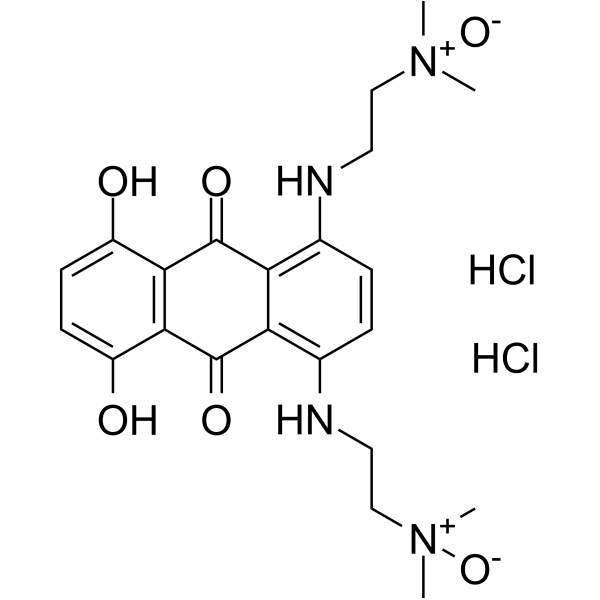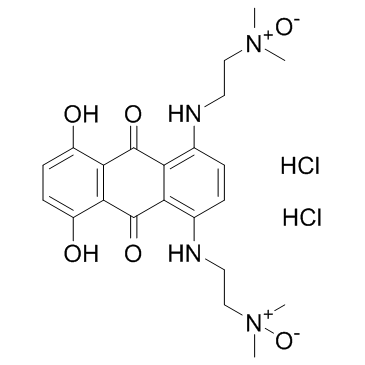Banoxantrone dihydrochloride AQ4N dihydrochloride,99.67%
产品编号:Bellancom-13562A| CAS NO:252979-56-9| 分子式:C22H30Cl2N4O6| 分子量:517.40
本网站销售的所有产品仅用于工业应用或者科学研究等非医疗目的,不可用于人类或动物的临床诊断或者治疗,非药用,非食用,
Banoxantrone dihydrochloride AQ4N dihydrochloride
| 产品介绍 | Banoxantrone dihydrochloride 是一种新型生物还原剂,可还原成稳定的 DNA 亲和性化合物 AQ4,AQ4 是一种有效的拓扑异构酶II抑制剂。 | ||||||||||||||||
|---|---|---|---|---|---|---|---|---|---|---|---|---|---|---|---|---|---|
| 生物活性 | Banoxantrone dihydrochloride is a novel bioreductive agent that can be reduced to a stable, DNA-affinic compound AQ4, which is a potent topoisomerase II inhibitor. | ||||||||||||||||
| 体外研究 |
Banoxantrone (AQ4N) can be reduced in a hypoxic environment to a stable DNA-affinic agent AQ4. AQ4, a potent topoisomerase II inhibitor, would be capable of damaging cells recruited into the cell cycle following radiation damage to the well-oxygenated cells of the tumor. Banoxantrone shows more than 8-fold higher cytotoxicity under hypoxia than normoxia in cultures of 9L rat gliosarcoma and H460 human non-small-cell lung carcinoma cells but not for 11 other human cancer cell lines. DT-diaphorase protein levels and banoxantrone chemosensitivity are poorly correlated across the cancer cell line panel, and banoxantrone chemosensitivity is not affected by DT-diaphorase inhibitors. Banoxantrone is a bis-N-oxide that is reduced via two sequential two-electron reductions to the tertiary amine, AQ4, which is a potent cytotoxic agent toward both aerobic and hypoxic cells. AQ4, but not AQ4N, intercalates in DNA with high affinity to generate a stable persistent complex that can inhibit topoisomerase II and cause DNA damage and cell death. 西域 has not independently confirmed the accuracy of these methods. They are for reference only. | ||||||||||||||||
| 体内研究 |
Banoxantrone (200 mg/kg) significantly enhances the tumor growth delay caused by radiation. This occurred when radiation is administered both as a single dose (12 Gy) and in a multifraction regimen (5x3 Gy). A study of the scheduling of Banoxantrone (AQ4N) administration shows that there is a very long time period over which a maximal effect can be elicited (drug given 4 days before to 6 h after radiation). These results suggest that Banoxantrone has significant potential as a bioreductive drug. The activation of banoxantrone cytotoxicity in vivo requires tumor hypoxia that is more extensive or prolonged than can readily be achieved by vasodilation or by antiangiogenic drug treatment. Incorporation of banoxantrone into conventional chemoradiation protocols therefore targets both oxygenated and hypoxic regions of tumors, and potentially will increase the effectiveness of therapy. A single dose of 60 mg/kg banoxantrone enhances the response of RT112 (bladder) and Calu-6 (lung) xenografts to treatment with cisplatin and radiation therapy. Banoxantrone will increase the efficacy of chemoradiotherapy in preclinical models. 西域 has not independently confirmed the accuracy of these methods. They are for reference only. | ||||||||||||||||
| 体内研究 |
Banoxantrone (200 mg/kg) significantly enhances the tumor growth delay caused by radiation. This occurred when radiation is administered both as a single dose (12 Gy) and in a multifraction regimen (5x3 Gy). A study of the scheduling of Banoxantrone (AQ4N) administration shows that there is a very long time period over which a maximal effect can be elicited (drug given 4 days before to 6 h after radiation). These results suggest that Banoxantrone has significant potential as a bioreductive drug. The activation of banoxantrone cytotoxicity in vivo requires tumor hypoxia that is more extensive or prolonged than can readily be achieved by vasodilation or by antiangiogenic drug treatment. Incorporation of banoxantrone into conventional chemoradiation protocols therefore targets both oxygenated and hypoxic regions of tumors, and potentially will increase the effectiveness of therapy. A single dose of 60 mg/kg banoxantrone enhances the response of RT112 (bladder) and Calu-6 (lung) xenografts to treatment with cisplatin and radiation therapy. Banoxantrone will increase the efficacy of chemoradiotherapy in preclinical models. 西域 has not independently confirmed the accuracy of these methods. They are for reference only. | ||||||||||||||||
| 性状 | Solid | ||||||||||||||||
| 溶解性数据 |
In Vitro:
DMSO : 12.5 mg/mL (24.16 mM; Need ultrasonic) H2O : 9.52 mg/mL (18.40 mM; ultrasonic and warming and heat to 60°C) 配制储备液
*
请根据产品在不同溶剂中的溶解度选择合适的溶剂配制储备液;一旦配成溶液,请分装保存,避免反复冻融造成的产品失效。 In Vivo:
请根据您的实验动物和给药方式选择适当的溶解方案。以下溶解方案都请先按照 In Vitro 方式配制澄清的储备液,再依次添加助溶剂:
——为保证实验结果的可靠性,澄清的储备液可以根据储存条件,适当保存;体内实验的工作液,建议您现用现配,当天使用;
以下溶剂前显示的百
| ||||||||||||||||
| 运输条件 | Room temperature in continental US; may vary elsewhere. | ||||||||||||||||
| 储存方式 |
-20°C, protect from light, stored under nitrogen *In solvent : -80°C, 6 months; -20°C, 1 month (protect from light, stored under nitrogen) | ||||||||||||||||
| 参考文献 |
|








 浙公网安备 33010802013016号
浙公网安备 33010802013016号